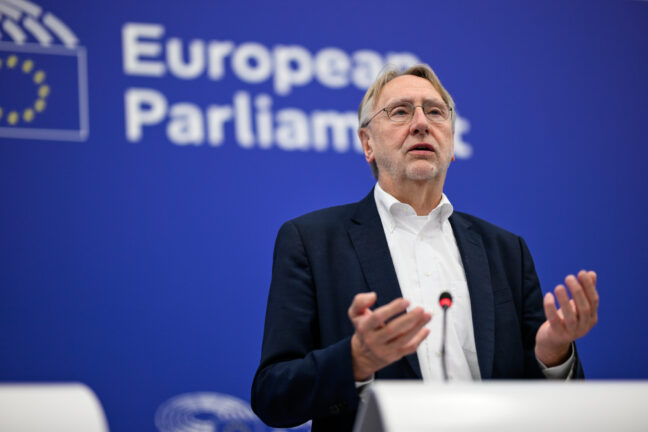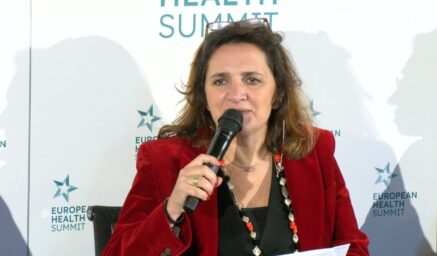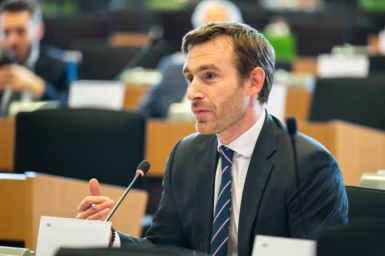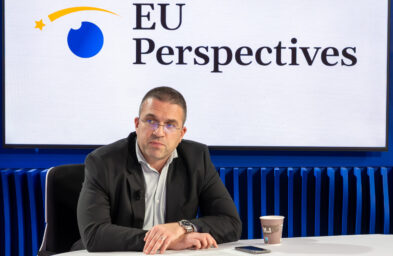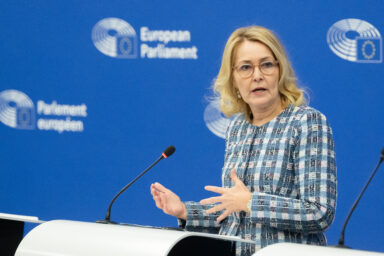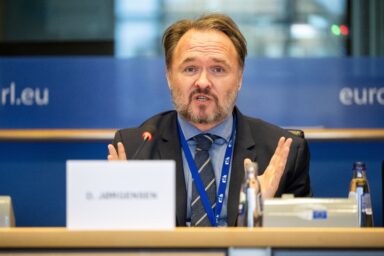The 1 August extension to the deadline of the EU-US trade talks does not mean much. The EU remains ready to impose retaliatory tariffs on 14 July but is still harbouring a collective hope for an agreement with Washington, the head of the European Parliament’s trade committee said on Wednesday.
What might have been the stage for the European Union’s decisive response to Washington unpredictably aggressive trade policies, ended up as the ultimate anticlimax. The Daphne Caruana Galizia press conference room in Strasbourg’s Louise Weiss building of the European Parliament saw a press conference on 9 July by a lone MEP. Bernd Lange (EPP/GER), Chair of the International Trade Committee (INTA), presented an accurate picture of the Union’s position in the talks: a mixture of bewilderment, hope, and a somewhat muted resolve to act.
“The European Union is still affected by illegal and unjustified tariffs from the United States,“ Mr Lange said in his opening remarks. “Currently, we are facing a 50 per cent tariff on steel and aluminium, including derivative products like fitness devices. There’s also a 25 per cent tariff on cars and car parts and a 10 per cent baseline tariff affecting about 70 per cent of our products.“
Trying to understand
“Additionally, under the Trade Act 232, there are tariffs on seven products such as semiconductors, pharmaceuticals, and trucks,“ Mr Lange continued. He added that the EU expects additional tariffs on some of these products soon, as US President Donald Trump announced a forthcoming 50 per cent tariff on copper on Tuesday.
“Of course, we do not accept these measures and are seeking a resolution with the United States for the withdrawal of tariffs,“ an exasperated Mr Lange told a handful of reporters. “We are trying to understand the real interests of the United States to find a common framework for deeper discussions in the coming weeks. The primary concern is sectorial tariffs, which target our industrial development. Steel, aluminium, cars, and copper, with prospects of including pharmaceuticals, are the main exports from the EU to the US.“
You might be interested
Like other European officials before him, the ranking MEP did his best to sound hopeful. “We have been in negotiations for about three weeks now, and there seems to be a corridor for understanding regarding tariffs on steel and cars, with possible exceptions from baseline tariffs,“ he said.
Wanted: Standstill clause
However, two main issues remain under discussion. “If we achieve a framework agreement, we expect a significant reduction in tariffs while we negotiate the details,“ Mr Lange said—before adding that, unfortunately, the US has not committed to this yet.
The second issue is the need for a standstill clause, ensuring a final package that protects the EU from further tariffs or other punitive measures. „In the initial draft of their tax bill, some additional tax measures against the EU were proposed, which are now removed,“ Mr Lange observed. “Nonetheless, nobody can predict future actions by President Trump’s administration, so a standstill clause is essential,“ he said in a tacit admission of Washington’s unpredictability adding a layer of complexity to the talks.
“This outlines the current situation. We aim to reach an understanding soon because these sectorial tariffs harm us significantly,“ the Parliament’s trade chief said. “Our countermeasures are ready and will automatically come into force on the 14th of July if necessary. Now is the time for agreement,“ he said in a tone voice usually reserved for ‘kumbaya‘.
Unfriendly letters
Mr Lange then remarked that although Mr Trump “mentioned the EU had been tough, he noted our recent niceness“, perhaps indicating willingness for an agreement. Surprisingly, Mr Trump then compared the EU unfavourably to China, illustrating the adversarial dynamic.
The INTA Chair reserved some particularly scathing criticism for President Trump’s tariff-related letters to 16 countries worldwide. “Those were not friendly letters,“ lacking diplomacy and representing power rather than partnership, he said. He expressed hope to move forward with an “understanding reflecting the need for mutual understanding and partnership in our world.“
We are trying to understand the real interests of the United States. – MEP Bernd Lange, Chair of INTA
„Ultimately, I hope for an agreement with the United States that respects the multilateral trading system. This objective aligns with a key requirement from the International Trade Committee of the European Parliament,“ Mr Lange reiterated the Union’s position.
Partnership and understanding
When asked about a potential agreement based on a 10 per cent tariff and whether the EU should apply its countermeasures while negotiations are still ongoing, Mr Lange emphasised the need to consider the entire package. He noted that the agreement should be an understanding on both sides, not dictated by one.
He stressed that if the US provides offers, it must happen within a partnership context. The MEP also acknowledged that while some exemptions like aircraft parts or alcoholic beverages might reduce their trading volumes, the baseline tariffs remain unjustified.
Regarding the timeframe for negotiations and the possibility of extending talks until August 1st, Mr Lange stated that this extension does not offer much respite since the central issue lies with sector-specific tariffs, not the 10 per cent baseline tariffs. He underscored the urgency for a final outcome, noting that sectors such as steel, automobiles, and pharmaceuticals, which heavily influence EU exports, are feeling disproportionate impact by proposed tariffs.
One person vs. 27 states
In response to a query about measures for handling the 10 per cent tariffs, Lange outlined the EU’s three-tier response strategy. He explained that the first stage involves tariffs on US products, set to automatically come into effect on July 14th if changes aren’t made.
The second stage considers imposing duties on exports to the US, such as on scrap metal, potentially putting pressure on the US, despite the EU’s own need for these materials. The third stage relates to services, where options like introducing a levy based on turnover could finance administrative costs, though digital tax poses challenges due to its complexity and the need for unanimous Council support.
Asked about the anticipated content of a potential letter from the US, Mr Lange noted that “we received an offer a few days prior and anticipated the letter would reflect this offer and ongoing talks“. He highlighted a key difference between the EU and US systems: the EU relies on democratic processes and stakeholder consultations, whereas in the US, decisions rest with a single individual, making it difficult to predict the outcome of such correspondence. „I have no clue what (Mr Trump) is deciding on this potential letter to the European Union,“ the MEP said pointedly.
